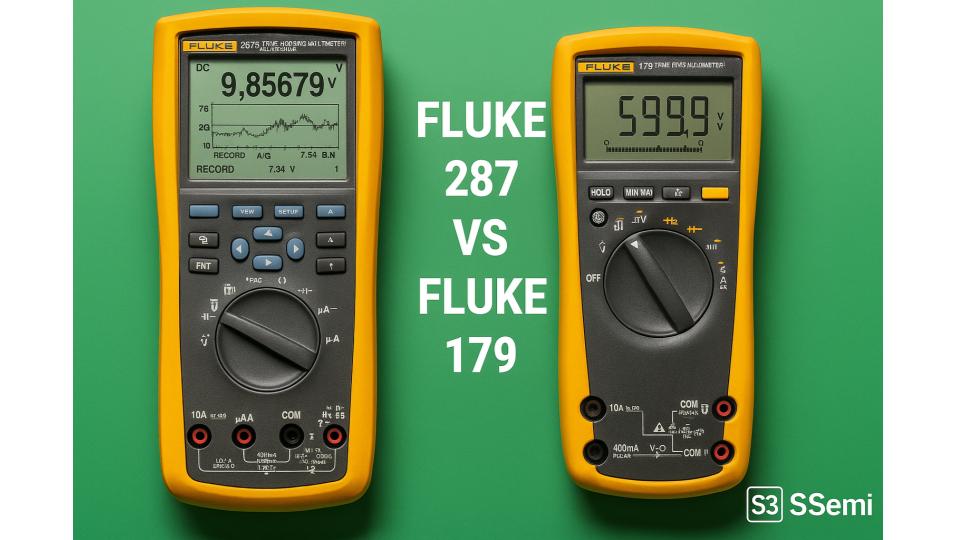Fluke is a leader in professional-grade test equipment, and two of their most talked-about multimeters are the Fluke 287 and the Fluke 179. While both are high-quality True RMS meters, they are built for different types of users.
🏷️ Fluke Multimeter Deals ⭐⭐⭐⭐⭐
The 179 is a reliable, everyday multimeter, while the 287 is a powerful logging meter for advanced diagnostics. Let’s break down the differences.
🔍 Overview of the Fluke 287
The Fluke 287 is part of Fluke’s advanced logging multimeter series. It’s designed for engineers and professionals who need high accuracy, data logging, and on-screen analysis.
Key Features:
- True RMS for accurate readings on non-linear loads
- Large, high-resolution dot-matrix display with TrendCapture™
- Logging and graphing of measurement data
- 50,000-count display (digitally enhanced up to 500,000)
- Min/Max/Average and Peak capture
- Measures AC/DC voltage, current, resistance, frequency, and capacitance
- USB interface for PC connectivity
- CAT IV 600V / CAT III 1000V safety rating
Best For: Engineers, R&D professionals, and advanced troubleshooting where data logging and high accuracy are essential.
⚡ Overview of the Fluke 179
The Fluke 179 is a rugged, reliable, and easy-to-use multimeter that’s a favorite among electricians and field technicians. It’s less complex than the 287 but perfect for everyday tasks.
Key Features:
- True RMS for accurate AC readings
- Clear digital display with analog bar graph
- Measures AC/DC voltage, current, resistance, continuity, frequency, and capacitance
- Temperature measurement with included thermocouple
- Backlit display for low-light environments
- Compact, durable design
- CAT III 1000V / CAT IV 600V safety rating
Best For: Electricians, HVAC technicians, and field workers who need a dependable multimeter for daily electrical troubleshooting.
📊 Side-by-Side Comparison Table
| Feature | Fluke 287 | Fluke 179 |
|---|---|---|
| True RMS | ✅ Yes | ✅ Yes |
| Display | High-resolution dot-matrix | Digital with analog bar graph |
| Data Logging | ✅ Yes (with TrendCapture) | ❌ No |
| Logging Capacity | Thousands of records | N/A |
| PC Connectivity | ✅ USB | ❌ No |
| Temperature | ❌ No | ✅ Yes |
| Count Resolution | 50,000 (500,000 max) | 6,000 |
| Safety Rating | CAT IV 600V / CAT III 1000V | CAT III 1000V / CAT IV 600V |
| Best For | Advanced diagnostics, engineering | Everyday fieldwork, electricians |
| 💳 Pricing | 💲 Check Price | 💲 Check Price |
✅ Pros and Cons of Each
Fluke 287 Pros:
- Advanced logging and graphing features
- Extremely high resolution and accuracy
- Excellent for long-term troubleshooting
- PC connectivity for detailed analysis
Fluke 287 Cons:
- Expensive compared to the 179
- Larger and heavier, less portable
- More complex interface (learning curve)
Fluke 179 Pros:
- Rugged, compact, and easy to use
- Includes temperature measurement
- Affordable compared to the 287
- Perfect for day-to-day electrician tasks
Fluke 179 Cons:
- No data logging or PC connectivity
- Lower resolution (6,000 counts vs 50,000+)
- Not ideal for advanced diagnostics
🏆 Verdict: Fluke 287 or Fluke 179?
The Fluke 287 and Fluke 179 are both excellent meters, but they serve very different needs.
- Choose the Fluke 287 if you need advanced logging, high-resolution measurements, and PC connectivity for R&D, engineering, or detailed troubleshooting.
- Choose the Fluke 179 if you want a reliable, rugged, and easy-to-use multimeter for daily electrical and HVAC work.
👉 In short:
- Fluke 287 = Advanced diagnostics and logging for professionals.
- Fluke 179 = Dependable everyday multimeter for electricians and technicians.
Whether the Fluke 287 is worth the higher price depends on your specific needs.
Is the Upgrade Worth the Extra Cost?
If you are an electrician or technician handling day-to-day troubleshooting, the Fluke 179 delivers all the essential functions at a lower cost, making it the more practical choice.
However, if you work in engineering, R&D, or industrial environments where data logging, high-resolution measurements, and advanced analysis are critical, the Fluke 287 easily justifies the extra investment.
In short, the 179 is a reliable workhorse, while the 287 is a precision instrument built for professionals who demand deeper insights.





